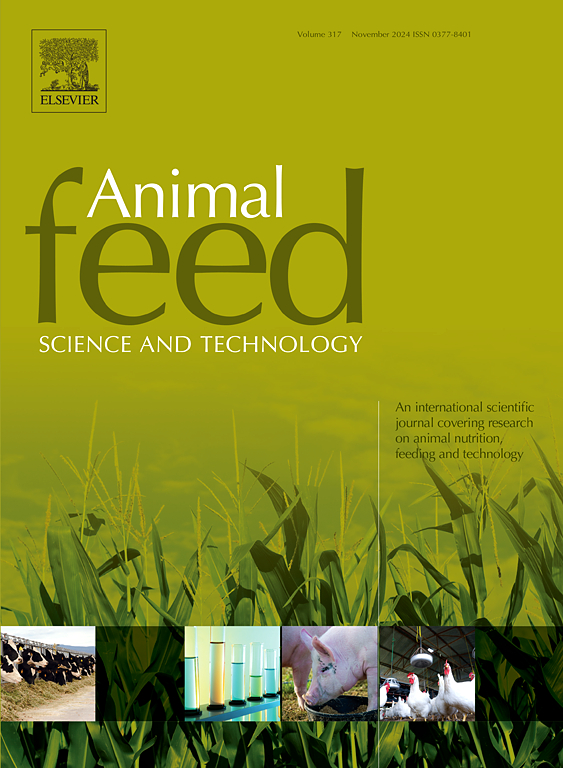饲粮中添加全麦对0 ~ 40日龄不同能量和营养密度肉鸡胃肠道发育和生长性能的影响
IF 2.7
2区 农林科学
Q1 AGRICULTURE, DAIRY & ANIMAL SCIENCE
引用次数: 0
摘要
本试验采用相同的试验方案和试验步骤,研究了不同能量和营养密度饲粮中添加全麦对罗斯308和科布500肉鸡孵化至40日龄胃肠道发育和生长性能的影响。试验设计为完全随机化,6个处理按2 × 3因子组织,日粮能量和营养密度(低;LD vs. high;HD)和WW补充(对照、低对照和高对照)作为主要效果。每个处理重复6次,实验单位为一栏,共16只鸡。饲喂计划分为3个阶段,高蛋白质组饲粮的可消化赖氨酸含量为0.419 MJ /kg,比低蛋白质组饲粮高5 %。此外,在0 ~ 14日龄,LD和HD饲粮中添加30 g WW/kg, 15 ~ 40日龄,LD和HD饲粮中添加75或150 g WW/kg。40日龄时,饲喂HD饲粮的肉鸡体重较重,料能比(P <;0.100),在两个试验中均高于LD饲粮。饲粮中添加全麦提高了体重,降低了沙囊pH值(P <; 0.05),但降低了增重和饲料效率(P <; 0.01)。综上所述,饲粮密度的增加提高了0 ~ 40日龄这两个品系的肉鸡生产性能,而添加WW的效果相反。本文章由计算机程序翻译,如有差异,请以英文原文为准。
Effects of whole wheat supplementation on gastrointestinal tract development and growth performance of two broiler strains fed diets differing in energy and nutrient density from 0 to 40 days of age
Two experiments, using the same protocol and experimental procedures, were conducted to study the effects of whole wheat (WW) supplementation to diets varying in energy and nutrient density, on gastrointestinal tract development and growth performance from hatch to 40 days of age of either Ross 308 or Cobb 500 broilers. The experimental design was completely randomized with 6 treatments organized as a 2 × 3 factorial with energy and nutrient density of the diet (low; LD vs. high; HD) and WW supplementation (control vs. low vs. high) as main effects. Each treatment was replicated 6 times and the experimental unit was a pen with 16 chicks. The feeding program consisted of three phases in which the HD diets contained 0.419 MJ AMEn/kg and 5 % digestible lysine more than the LD diets. In addition, the LD and HD diets were supplemented with 30 g WW/kg from 0 to 14 days and either 75 or 150 g WW/kg from 15 to 40 days of age. At 40 days of age, broilers fed the HD diets were heavier and had better feed and energy conversion ratio (P < 0.100), in both experiments, than broilers fed the LD diets. Whole wheat supplementation increased the weight and decreased the pH of the gizzard (P < 0.05), but impaired BW gain and feed efficiency (P < 0.01). In summary, an increase in diet density improved broiler performance of both strains from 0 to 40 days of age with opposite effects observed with WW supplementation.
求助全文
通过发布文献求助,成功后即可免费获取论文全文。
去求助
来源期刊

Animal Feed Science and Technology
农林科学-奶制品与动物科学
CiteScore
6.00
自引率
6.20%
发文量
266
审稿时长
3 months
期刊介绍:
Animal Feed Science and Technology is a unique journal publishing scientific papers of international interest focusing on animal feeds and their feeding.
Papers describing research on feed for ruminants and non-ruminants, including poultry, horses, companion animals and aquatic animals, are welcome.
The journal covers the following areas:
Nutritive value of feeds (e.g., assessment, improvement)
Methods of conserving and processing feeds that affect their nutritional value
Agronomic and climatic factors influencing the nutritive value of feeds
Utilization of feeds and the improvement of such
Metabolic, production, reproduction and health responses, as well as potential environmental impacts, of diet inputs and feed technologies (e.g., feeds, feed additives, feed components, mycotoxins)
Mathematical models relating directly to animal-feed interactions
Analytical and experimental methods for feed evaluation
Environmental impacts of feed technologies in animal production.
 求助内容:
求助内容: 应助结果提醒方式:
应助结果提醒方式:


